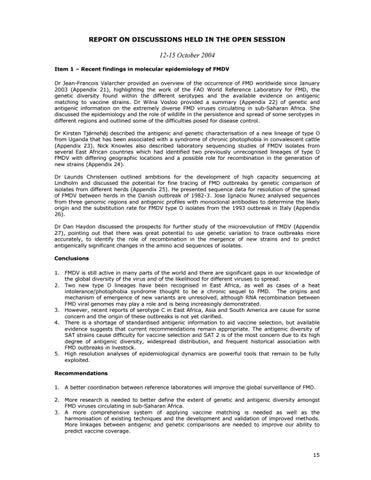REPORT ON DISCUSSIONS HELD IN THE OPEN SESSION
12-15 October 2004 Item 1 – Recent findings in molecular epidemiology of FMDV Dr Jean-Francois Valarcher provided an overview of the occurrence of FMD worldwide since January 2003 (Appendix 21), highlighting the work of the FAO World Reference Laboratory for FMD, the genetic diversity found within the different serotypes and the available evidence on antigenic matching to vaccine strains. Dr Wilna Vosloo provided a summary (Appendix 22) of genetic and antigenic information on the extremely diverse FMD viruses circulating in sub-Saharan Africa. She discussed the epidemiology and the role of wildlife in the persistence and spread of some serotypes in different regions and outlined some of the difficulties posed for disease control. Dr Kirsten Tjǿrnehǿj described the antigenic and genetic characterisation of a new lineage of type O from Uganda that has been associated with a syndrome of chronic photophobia in convalescent cattle (Appendix 23). Nick Knowles also described laboratory sequencing studies of FMDV isolates from several East African countries which had identified two previously unrecognised lineages of type O FMDV with differing geographic locations and a possible role for recombination in the generation of new strains (Appendix 24). Dr Laurids Christensen outlined ambitions for the development of high capacity sequencing at Lindholm and discussed the potential for fine tracing of FMD outbreaks by genetic comparison of isolates from different herds (Appendix 25). He presented sequence data for resolution of the spread of FMDV between herds in the Danish outbreak of 1982-3. Jose Ignacio Nunez analysed sequences from three genomic regions and antigenic profiles with monoclonal antibodies to determine the likely origin and the substitution rate for FMDV type O isolates from the 1993 outbreak in Italy (Appendix 26). Dr Dan Haydon discussed the prospects for further study of the microevolution of FMDV (Appendix 27), pointing out that there was great potential to use genetic variation to trace outbreaks more accurately, to identify the role of recombination in the mergence of new strains and to predict antigenically significant changes in the amino acid sequences of isolates. Conclusions 1. FMDV is still active in many parts of the world and there are significant gaps in our knowledge of the global diversity of the virus and of the likelihood for different viruses to spread. 2. Two new type O lineages have been recognised in East Africa, as well as cases of a heat intolerance/photophobia syndrome thought to be a chronic sequel to FMD. The origins and mechanism of emergence of new variants are unresolved, although RNA recombination between FMD viral genomes may play a role and is being increasingly demonstrated. 3. However, recent reports of serotype C in East Africa, Asia and South America are cause for some concern and the origin of these outbreaks is not yet clarified. 4. There is a shortage of standardised antigenic information to aid vaccine selection, but available evidence suggests that current recommendations remain appropriate. The antigenic diversity of SAT strains cause difficulty for vaccine selection and SAT 2 is of the most concern due to its high degree of antigenic diversity, widespread distribution, and frequent historical association with FMD outbreaks in livestock. 5. High resolution analyses of epidemiological dynamics are powerful tools that remain to be fully exploited. Recommendations 1. A better coordination between reference laboratories will improve the global surveillance of FMD. 2. More research is needed to better define the extent of genetic and antigenic diversity amongst FMD viruses circulating in sub-Saharan Africa. 3. A more comprehensive system of applying vaccine matching is needed as well as the harmonisation of existing techniques and the development and validation of improved methods. More linkages between antigenic and genetic comparisons are needed to improve our ability to predict vaccine coverage.
15











